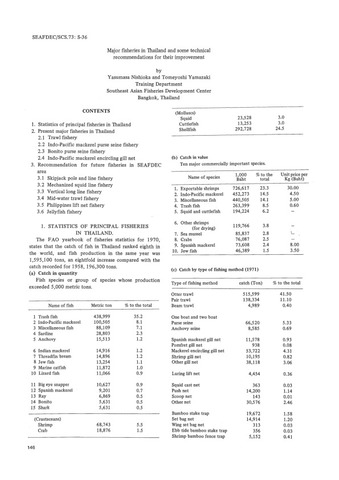The Situation of Small tuna Fishery in the Gulf of Thailand from 1978 to 1988 Based on Multivariate Analysis
Share
Abstract
The situation of small tuna fishery in the Gulf of Thailand was analysed by principal component analysis and cluster analysis, using the data in the SEAFDEC Fishery statistical Bulletins and the Catch-Effort Statistics for 1978 to 1988. In purse seine fishery, the 11 years were divided into two groups, i .e., from 1978 to 1984 and from 1985 to 1988. The first group of years (1978-19B4) showed the following features: 1) a drastic reduction in sardine catcher; 2) a drastic one-fifth reduction in round scad catches from 105,600 MT in 1978 ta 22,300 MT in 1979; and 3) a dramatic increase in longtail tuna catches from 1983, kawakawa from 1982 and Indo-Pacific mackerel from 1981. The second group of years (1985-1988) showed following: 1)a steadily increasing trend in longtail tuna catches; 2) stable catches of kawakawa, do-Pacific mackerel and sardine; 3) grow in catches of jack-cavalla trevally, hardtail scad, black pomfret and anchovy from the previous group of years; 4) large increases in catches of longtail tuna, kawakawa and jack-cavalla trevally in 1985 and 1988. The situation of small tuna fishery by purse seine in the Gulf of Thailand was summarized by catches of longtail tuna and kawakawa increasing dramatically from the early 1980s, with an early peak reached in 1983; this was because much effort was spent in catching small tunas by vessels equipped with modern electronic equipment. In catches of small tunas creased both in 1985 and 1988 because of expansion of the fishing grounds to the central Gulf, and off Malaysia and Indonesia. A large increase in the cases of small tunas will be difficult other than by further expansions of fishing grounds and proper management of small tuna fishery by purse seine, in the Gulf of Thailand and its vicinity with consideration to fisheries interactions and the life histories of major species. In drift gill net fishery, the 11 years were divided into two groups of years, i.e., from 1978 to 1981 and from 1982 to 1988. The first group of years (1978-1981) showed a steady increase in catches of narrow-barred king mackerel, longtail tuna and kawakawa, and positive catch relationships between the three species. The second group of years (1982-1988) showed increasing trends in longtail tuna and kawakawa catches with a temporary decrease in narrow-barred king mackerel, and negative relation- ships of CPUE values in longtail tuna and kawakawa compared to narrow-barred king mackerel. Small tuna fishery by drift gill net in the Gulf of Thailand shored catches of longtail tuna and kawakawa increasing from the early 1980s, as with purse seine drift gill net target species then changed from narrow-barred king mackerel to longtail tuna and kawakawa between 1982 and 1985. As catches of longtail tuna, kawakawa and narrow-barred king mackerel were similar to each other after 1985 and the total catches of drift gill net fishery from 1982 to 1988 were stable, it is considered that drift gill net catches of small tunas and narrow barred king mackerel were stable after 1985 in the Gulf of Thailand.
Suggested Citation
Yanagawa, H. (1992). The situation of small tuna fishery in the Gulf of Thailand from 1978 to 1988 based on multivariate analysis. Samut Prakarn, Thailand: Training Department, Southeast Asian Fisheries Development Center.
Subject
Koleksi
- SEAFDEC/TD [12]
Related items
Showing items related by title, author, creator and subject.
-
The Status of Fisheries in the Republic of Maldives
Faiz, Mohamed (Training Department, Southeast Asian Fisheries Development Center, 1997)The paper discusses the tuna fisheries in Maldives which dominates its fishing industry. Apart from a very strong domestic market, tuna is also the main export commodity of the country. Moreover, reef fisheries such as, ... -
Major fisheries in Thailand and some technical recommendations for their improvement
Nishioka, Yasumasa; Yamazaki, Tomeyoshi (Japan International Cooperation Agency, 1977)Presented in this paper is the development of fisheries industry in Thailand. The data on the production of the principal fisheries species and major fishing methods are also presented. Also included are the recommendations ... -
Status of Fishing Conditions in Cambodia
Sour, Kim; Vuthy, Ros (Training Department, Southeast Asian Fisheries Development Center, 1997)Fisheries in plays a very important role in Cambodia’s national economic development. Total fish catch production in 1996 was 104 310 tones, about which 60% was contributed by inland capture fisheries, 30% by marine capture ...





